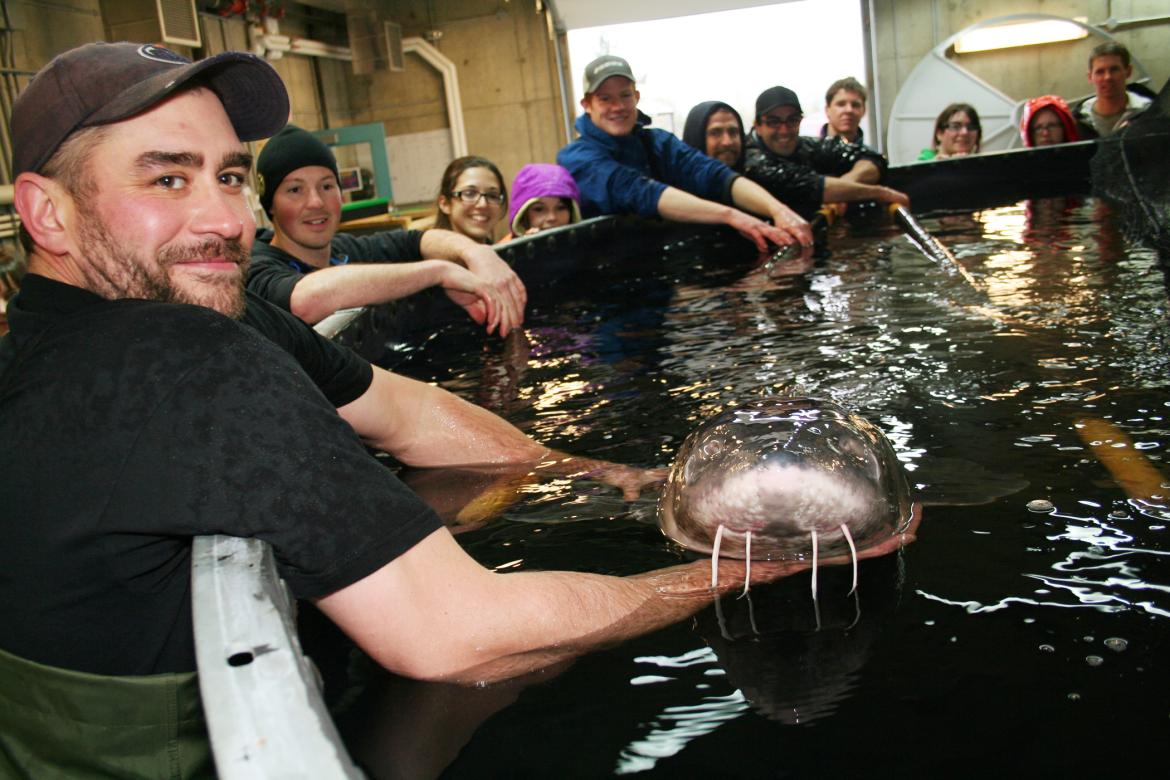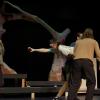
February 13, 2013 - 5:58am
FOR IMMEDIATE RELEASE: Wednesday, February 13, 2013
NANAIMO, BC – It’s not every day that Vancouver Island University students get ‘up close and personal’ with a 200-pound Jurassic-era fish commonly referred to as a ‘living fossil.’
Today, aquaculture technicians and students moved three large white sturgeon into a new holding tank inside the International Centre for Sturgeon Studies (ICSS) at VIU’s Nanaimo campus.
It was a delicate operation moving Tyra, Angie and Dottie. Sturgeon technician Dave Switzer served as the main quarterback.
“These fish are five to seven feet in length. Our biggest, Tyra, weighs 200 pounds,” says Switzer. “Our goal was to move the fish while minimizing stress on them to the greatest degree possible – especially as some of them will be spawning this June.”
ICSS Director Don Tillapaugh is enthusiastic about the move. “For years, we have housed our eight sturgeon brood stock (fish old enough to spawn) in tanks located inside an old greenhouse,” he says.
“The ICSS provides a better, safer and more secure home for the fish in a state-of-the-art facility.”
The ICSS opened in October 2011. Over the past year, technicians have been setting up equipment, and completing and testing the state-of-the-art freshwater closed containment recirculation system. Various populations of smaller fish have already been moved into their new home, and are doing well.
“Moving the biggest fish into the ICSS is an exciting time for us,” says longtime VIU Fisheries and Aquaculture technician Gord Edmondson. “We’re using this opportunity to involve VIU students and train them in fish handling methods. It is not every day you can get up close and personal with a living fossil. The students are very excited.”
Student Allan Maika, a first year Fisheries and Aquaculture technology student, is thrilled to have a chance to handle the big fish.
“I’m a member of the VIU student sturgeon group,” says Maika. “I participate in measuring and weighing the sturgeon and taking care of them. These fish are so much larger than any other fresh water fish in BC or North America. It’s incredible to think that they haven’t evolved that much in over 200-million years. It’s exciting to move the fish into the new building and see the progress of the new systems there.”
VIU has been involved in sturgeon research since the 1980s. It is the only academic institution in western Canada to have captive white sturgeon brood stock. Some of VIU’s fish were rescued from backyard ponds.
In 1991, VIU researchers successfully conducted the first-ever captive spawning of Fraser River white sturgeon. In 2000, 2001 and 2004, VIU provided fertilized eggs and fry for the start-up of BC's only commercial white sturgeon culture operation in Sechelt, BC. That company, Target Marine Hatcheries, began harvesting caviar and sturgeon meat in 2011, and their white sturgeon caviar – Northern Divine - was ranked among the top five sustainable caviars in the world at a global competition.
Meanwhile, according to Tillapaugh, almost all of the world’s 28 species or subspecies of sturgeon are endangered, threatened or near extinction, making conservation efforts and sturgeon research more important than ever.
Future research conducted in the ICSS will investigate the viability of environmentally responsible sturgeon aquaculture through land-based, closed containment facilities.
The 1,208 square-metre facility includes innovative fish holding facilities, fresh water recirculation technology, five wet laboratories, a dry lab for sample processing and analysis, and lab equipment for specialized research in environmental physiology, forensic, nutrition, health, reproduction and genetic research.
“The Centre’s mission is to become a hub for knowledge and innovation,” Tillapaugh adds. “Eventually, we hope to include a public education component in the ICSS, where school children and others can learn about sturgeon conservation and protection, ecology and watersheds.”
The ICSS was showcased at a conference of the North American Chapter of the World Conservation Society held at VIU in July 2011, and now Tillapaugh and his team are organizing the 7th International Symposium on Sturgeon July 21-25, 2013.
The five-day symposium, hosted by VIU and the City of Nanaimo, is expected to draw over 600 delegates including educators, researchers, environmentalists, industry members and sturgeon enthusiasts from 35 countries around the world.
The international symposium, which occurs once every four years, will be held at the Vancouver Island Conference Centre in downtown Nanaimo with workshops at the ICSS.
ICSS funding partners include Canada Foundation for Innovation, BC Knowledge Development Fund, Island Coastal Economic Trust, Western Diversification, Community Futures WestCCAP, Vancouver Island University and Marine Harvest Canada.
For more information:
International Centre for Sturgeon Studies: http://www.viu.ca/sturgeon/
Facilities Services and Campus Development: http://www.viu.ca/facilities/
VIU Office of Development and Alumni (for donations): http://www.viu.ca/giving/
-30-
BACKGROUNDER – KEY FACTS ABOUT STURGEON
• Sturgeon, often called ‘living fossils’, date back to the Jurassic period over 200 million years ago.
• They are the largest freshwater fish in the world and only live in the northern hemisphere.
• Almost all of the world’s 28 species or subspecies of sturgeon are endangered, threatened or near extinction.
• Poaching, pollution, overfishing and loss of habitat threaten the sturgeon’s survival worldwide.
• Saving these prehistoric fish is vital because sturgeon are at the top of the aquatic food chain. Healthy wild sturgeon populations are a key indicator of environmentally healthy river ecosystems.
• The World Sturgeon Conservation Society identified a need for a dedicated sturgeon research centre in North
America.
• The largest sturgeon species in the world is the Beluga sturgeon found in the Caspian Sea in Iran. They can grow to 26 feet in length and weigh over 3,000 pounds.
• Five species of sturgeon are found in Canada, including two on the Pacific Coast - green sturgeon and white sturgeon. In BC, white sturgeon live in the Fraser and Columbia river systems, with the largest populations in the lower Fraser River. There have been sightings in the Somass River in Port Alberni, the Nanaimo River and other coastal rivers.
• White sturgeon can grow to over 19 feet and weigh over 1,700 pounds, however, it is widely believed that the very large (1,000 pound-and-over specimens) have been fished out. In 1897, a white sturgeon was landed in New Westminster, weighing 1,384 pounds, possibly one of the last of the big fish in the Fraser River.
• In BC, white sturgeon provide a catch and release sport fishery worth millions of dollars annually in the lower Fraser River.
• BC white sturgeon are being considered for endangered species status under the federal government's Species at Risk Act.
• Although they look like sharks, sturgeon are not related to sharks at all.
• Sturgeon have five rows of bony plates called "scutes" running down their body, and four "barbells" or whiskers hanging down in front of their mouth.
• Sturgeon do not have any teeth, and feed mostly on fish, dead or alive.
• Sturgeon eggs, known as true caviar, are a gourmet delicacy. The most expensive caviar comes from the Beluga sturgeon. The caviar industry worldwide generates some $100-million in annual sales.
• Sturgeon fillets are also widely prized.
• In the United Kingdom, sturgeon are known as the "Royal Fish." According to medieval law, anyone who catches a sturgeon must present it to the Queen.
• California has developed a multi-million dollar commercial sturgeon farming industry for both meat and caviar, due largely to the efforts of researchers at the University of California, Davis.
-30-
ABOUT VIU: Vancouver Island University is Canada’s west coast university. Known as a centre of excellence for teaching, learning and applied research, VIU offers a diverse range of certificate, diploma and undergraduate and master degree programs to more than 18,000 students on campuses in Nanaimo, Powell River and Cowichan, and at the Parksville-Qualicum Centre. For more information visit www.viu.ca
Media Contact
Janina Stajic, Manager, Vancouver Island University
P: 250.740.6288 E: Communications@viu.ca Twitter: @VIUNews
Tags: In the Community






